Shijô
Wren and old pine covered with snowSigned: Rôryûkan Shônen Senshi hitsu
Seals: Shônen, .. (top) & Ichihen hyôshin zaigyoku .. (bottom)
Technique: sumi, some yellow and gofun on paper 126 x 29.8
Date: Winter of 1909 (at the bottom)
Mounting: bronze damask and beige silk and ceramic rollers by Kiyomizu Rokubei IV (1847-1920) 211 x 43.2
Box: signed in the winter of 1909, Rôryûkan Shônen Senshi dai
Condition: very good
Shônen’s life-style is reflected in his paintings: bold and full of self-confidence.
He was the son and pupil of the Kyoto Shijô artist Suzuki Hyakunen (1825-1891). At a very early age he already achieved great skill and worked in a spontaneous, bold and impromptu manner. In 1881 he succeeded Kôno Bairei (1844-1895) at the Kyôto Art Academy, teaching Northern Chinese painting, where he taught until 1888. In 1886 he also started teaching at the Kyôto Prefectural School of painting, the same school he attended as a pupil. In his later years Shônen was an extremely influential person in the Kyôto art circles.
Reference:
Roberts p. 167
Araki p. 2792
Aburai. p. 218
Morioka & Berry ‘99 p. 106-111
Morioka & Berry ‘08
Rokubei IV (Shôrin) was the first son of Rokubei III (Shôun). He studied painting with Shiokawa Bunrin (1801-1877). After his father’s death he inherited the family title in 1883. He was a close friend of Tomioka Tessai (1836-1924) and of Kôno Bairei (1844-1895). Rokubei IV was a great promoter of kyôyaki and already in 1884 he established the Ceramics Commercial and Industrial Association. He actively studied design and participated in the Yûtôen, organized by Asai Chû (1856-1907) and in the Kabikai, presided over by Kamisaka Sekka (1866-1942).
In 1913 he retired due to poor health, transferring the title of the family to his second son Kuritarô, who became Rokubei V (Shôrei) (1875-1959). He then took the artist’s name Rokkyo. The style of Rokubei IV is quiet and elegant, reflecting his own refined character. His works are considered the best among all the works of the succeeding Rokubei generations.
Reference:
Sekka, Kyoto 2003 p. 326
Price: SOLD

